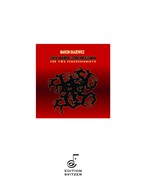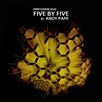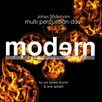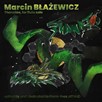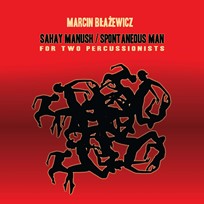
Sahay Manush
Composer: Marcin Blazewicz
Instrument: Percussion Duo
Level: Advanced
Published: 2009
Price: €38.00
Item details
-
Description +
-
Duration: 15 min.
In the work Sahay Manush written for the duo by Marcin Blazewicz the contradictions between the marimba and unmelodic instruments, between soft and harsh sounds, static and dynamics, are based on the philosophy of Yin and Yang. The idea of creative spontaneity comprised in the virtuosic and improvisatory passages is influenced by the poetry of the Bengali Bauls, who strived to attain the essence of matters by the free development of their improvised poems. “If you want to be happy, enjoy your life and be more alert in order to realize what is important and what is not. If you keep opting for what is essential, sooner or later you will become an essential man, adbar manush. In order to achieve that, one must be a spontaneous, unconstrained man, sahaj manush.”
The composition consists of well defined components such as form, and elements which can be changed, such as used instruments.
There is a part which gives an opportunity to present the musicians’ improvisation skills. The second percussionist can perform his own spontaneous improvisation within the bars 170-214, instead of following the written part.
The musicians can also select their own set of instruments. The instruments marked with a star on the List of required instruments can be replaced with other instruments from the same family. For example :tam-tam can be changed for other metallophone, a sort of gong , Bell Plates or others. Roto-tom for other membranophone, such as boobams. The other instruments can be replaced the same way.
The list of required instruments is the composer’s proposal. It can be replaced with the musicians’ own list depending on instruments at their disposal or which instruments are easier to transport than the others.
-
-
Instrumentation +
-
Percussion Duo:
I batteria:
marimbafono (mbf.)
3 crotali (crtl.)* 3 triangoli (trgl.)*
3 chinese opera-gongs (gg gliss.)
3 dabachi (Japanese Temple Bells)(dab.)*
3 tom-toms (tomt.)*
II batteria*:
3 crotali (crtl.)
5 chinese opera-gongs (gg gliss.)
3 piatti sospesi (ptt.)
2 tam-tams (tmt.)
2 blocchi di legno (bl.d.l.)
tamburo (tmb.)
roto-tom (rot.)
2 bongos (bg.)
conga (cg.)
5 tom-toms (tomt.)
gran cassa (gr.c.)
gran cassa con pedale (gr.c.c.p.)(foot pedal)*) These instruments are optimal to use but you may also use other appropriate instruments
-
-
About the composer +
-
Composer and teacher. Born in Warsaw in 1953. He began to study music when he was 13 years old, first at the Oskar Kolberg primary Music School then at the F. Chopin Secondary Music School (double bass). Upon passing his secondary school leaving examination (matura) he studied natural philosophy at the Academy of Catholic Theology for one year (1975/76). Upon graduating from secondary music school in 1977 he began to study at the Department of Composition, Conducting and Theory of Music at the Fryderyk Chopin Academy of Music in Warsaw in Professor Marian Borkowski's class of composition which he finished with honours (1977-1982). He attended composer courses led by François Bernard Mâche (Pécs, Hungary 1980) and Yannis Xenakis (Salzburg, Delft 1985), obtained a SACEM scholarship from Sociéte des Compositeurs et Editeurs de Musique (France) and, as holder of an Acanthes scholarship, he attended a course in composition led by Olivier Messiaen in Avignon (France) in 1987.
Professor Marcin Błażewicz has been a member of the faculty of the AMFC in Warsaw since 1985, first as assistant then tutor (1996-2003) and finally as associate professor at the Chair of Composition. He teaches the following subjects: score reading and introduction to composition and instrumentation (his main interest). He has supervised many master's theses. He was deputy dean of FCUM Department I in 1999-2002 and 2005-2008. In 2008 he was elected dean of the Department of Composition, Conducting and Theory of Music for term 2008-2012.
Marcin Błażewicz presented a paper "On the situation in Polish Music after 1989" at the 5th Biennial "La recherche musicale en Europa" (Gif-sur-Yvette, France 1992). He has organised more than 200 concerts propagating contemporary music including several cycles: Presentation of Young Composers, Encounters with Contemporary Music, Young Musicians for Young Audiences (Warsaw 1979-81). Artistic director and founder of the International New Music Forum festival (Warsaw 1983-87), artistic director of the International Festival "Jeunesses Musicales" (Częstochowa, 1986, Warsaw 1990). Co-founder of the Modus group (1983), music advisor to the French Institute in Warsaw (1985-86). Member of the jury of the International Radio Festival Prix Italia (Peruggia 1989). Musical director of the Polish Radio Theatre (1986-97). Editor-in-chief of the journal "Muzyka21" (2000-2001). Since 2005 he has been holding a class of composition in Fryderyk Chopin University of Music/ FCUM/.
-
-
Reviews +
-
Review (Percussive Notes, July (60) 2012)
This composition features the contrast between marimba and non-pitched textures. Although the marimba is the feature instrument for the first percussion part, additional instruments include crotales, triangles, Chinese opera gongs, Japanese temple bells, and tom-toms. The second player has a huge number of colors to master, including crotales, suspended cymbals, and a collection of 12 tom-toms ranging from both pedal and regular bass drums up to bongo drums.
The work features a broad spectrum of dynamics, long tones contrasted with rapid rhythmic figures, and mixtures of wood and metal or wood and membrane sounds. The rhythmic figures are mostly standard patterns, with much creativity in how the two players interact with each other. There are also sections that encourage improvisation by each performer.
This is a very unique work, and hopefully will appear on many contemporary recital and chamber music programs.
—George Frock
-
-
Credits +
-
Front Cover artist: Marta Paulat
Front Cover graphics and layout: Ronni Kot Wenzell
Engraving: Jerzy Wolosiuk
Printed in Copenhagen, Denmark
Copyright © Edition Svitzer
www.editionsvitzer.com
-
